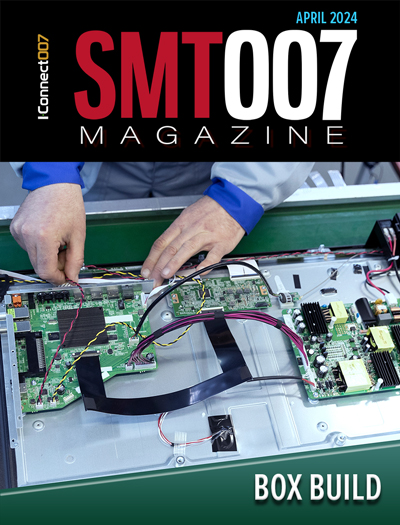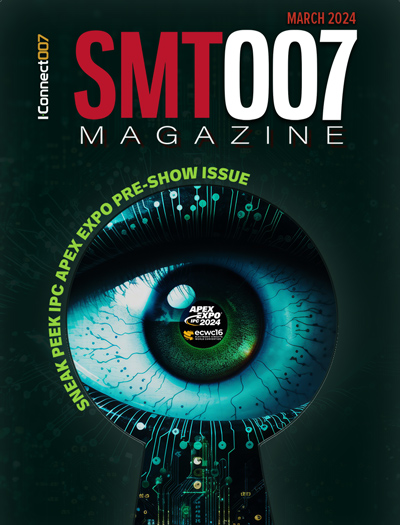-

- News
- Books
Featured Books
- smt007 Magazine
Latest Issues
Current Issue
Box Build
One trend is to add box build and final assembly to your product offering. In this issue, we explore the opportunities and risks of adding system assembly to your service portfolio.

IPC APEX EXPO 2024 Pre-show
This month’s issue devotes its pages to a comprehensive preview of the IPC APEX EXPO 2024 event. Whether your role is technical or business, if you're new-to-the-industry or seasoned veteran, you'll find value throughout this program.

Boost Your Sales
Every part of your business can be evaluated as a process, including your sales funnel. Optimizing your selling process requires a coordinated effort between marketing and sales. In this issue, industry experts in marketing and sales offer their best advice on how to boost your sales efforts.
- Articles
- Columns
Search Console
- Links
- Events
||| MENU - smt007 Magazine
Top Five Takeaways from IPC APEX EXPO 2021
April 15, 2021 | Chris Mitchell, IPC VP, Global Government RelationsEstimated reading time: 2 minutes
IPC APEX EXPO 2021, which went all virtual this year, exemplified how the electronics industry has responded to the COVID-19 global pandemic: with resiliency, agility, and an unwavering commitment to build electronics better. APEX EXPO featured great content and robust discussions on topics of critical importance to the global electronics industry.
From my vantage point leading IPC’s government relations programs, here are my top five takeaways from this year’s event.
1. Factory of the Future grabs the spotlight. What a difference a year makes! At last year’s APEX EXPO, Matt Kelly had just assumed his new role as IPC’s chief technologist. A year later, he is implementing IPC’s bold, new Factory of the Future initiative, which he developed in concert with IPC members, and which will help guide the industry through the next industrial revolution. Presentations by Matt, IndustryWeek’s Travis Hessman, and others reinforced the promise of the factory of the future (F2), but also the challenging, incremental progress necessary to achieve this vision.
While Matt is focused on helping the industry leverage F2 solutions to address various business challenges, the IPC government relations team is making the factory of the future the centerpiece of our industry’s advocacy. Policymakers around the world are deliberating on new industrial policies to strengthen their economic competitiveness. F2 offers a path to stronger manufacturing, and governments have an opportunity to implement policies that accelerate that migration. IPC is already carrying this message to the Biden administration and the European Commission, encouraging them to better support our industry’s R&D and capital expenditures.
2. Rave reviews for this year’s technical conference. I spoke to more than a few APEX EXPO participants who said this year’s technical conference was among the best, if not the best ever. A lot of great content on big issues like cybersecurity, data analytics, traceability, assembly materials and design, but a special nod to the interest generated by those sessions focused on reliability. The high attendance in these sessions spoke volumes; the industry is facing rising expectations about the reliability of electronics products and services. High-reliability systems often involve miniaturized commercial electronics function 24/7 in harsh-use environments. And they must meet these requirements even as the industry moves away from the use of lead, introduces new laminate materials, and leverages innovative manufacturing technologies to support smaller vias on higher density designs.
The industry’s intense interest in reliability should be a wake-up call for policymakers, many of whom have ignored the need for heavier investments in R&D and capital equipment in assembly and PCB manufacturing, even as they have deployed billions to support the semiconductor and microelectronics industries. It is past time for governments in Europe and North America, in particular, to adopt a more holistic approach to the industrial ecosystem that supports electronics manufacturing. The ecosystem’s strength relies on meaningful investments across its many sub-sectors if we are to realize goals around resiliency, security, and innovation.
To read this entire article, which appeared in the 2021 edition of Show & Tell Magazine, click here.
Suggested Items
Warm Windows and Streamlined Skin Patches – IDTechEx Explores Flexible and Printed Electronics
04/26/2024 | IDTechExFlexible and printed electronics can be integrated into cars and homes to create modern aesthetics that are beneficial and easy to use. From luminous car controls to food labels that communicate the quality of food, the uses of this technology are endless and can upgrade many areas of everyday life.
Book Excerpt: The Printed Circuit Assembler’s Guide to... Factory Analytics
04/24/2024 | I-Connect007 Editorial TeamIn our fast-changing, deeply competitive, and margin-tight industry, factory analytics can be the key to unlocking untapped improvements to guarantee a thriving business. On top of that, electronics manufacturers are facing a tremendous burden to do more with less. If you don't already have a copy of this book, what follows is an excerpt from the introduction chapter of 'The Printed Circuit Assembler’s Guide to... Factory Analytics: Unlocking Efficiency Through Data Insights' to whet your appetite.
Listen Up! The Intricacies of PCB Drilling Detailed in New Podcast Episode
04/25/2024 | I-Connect007In episode 5 of the podcast series, On the Line With: Designing for Reality, Nolan Johnson and Matt Stevenson continue down the manufacturing process, this time focusing on the post-lamination drilling process for PCBs. Matt and Nolan delve into the intricacies of the PCB drilling process, highlighting the importance of hole quality, drill parameters, and design optimization to ensure smooth manufacturing. The conversation covers topics such as drill bit sizes, aspect ratios, vias, challenges in drilling, and ways to enhance efficiency in the drilling department.
Elevating PCB Design Engineering With IPC Programs
04/24/2024 | Cory Blaylock, IPCIn a monumental stride for the electronics manufacturing industry, IPC has successfully championed the recognition of the PCB Design Engineer as an official occupation by the U.S. Department of Labor (DOL). This pivotal achievement not only underscores the critical role of PCB design engineers within the technology landscape, but also marks the beginning of a transformative journey toward nurturing a robust, skilled workforce ready to propel our industry into the future.
Winner of The Science Show Rakett 69 Receives Incap Scholarship
04/24/2024 | IncapThe winner of the Rakett 69 science show, Andri Türkson, who stood out as an electronics enthusiast, received a scholarship from Incap Estonia, along with an internship opportunity in Saaremaa.


